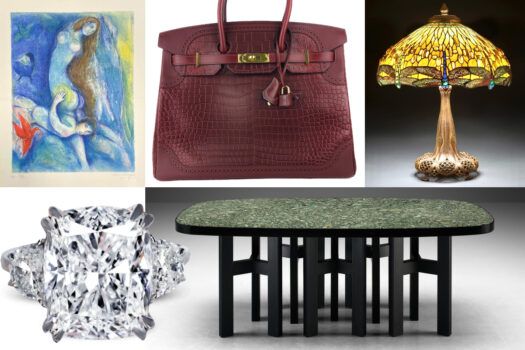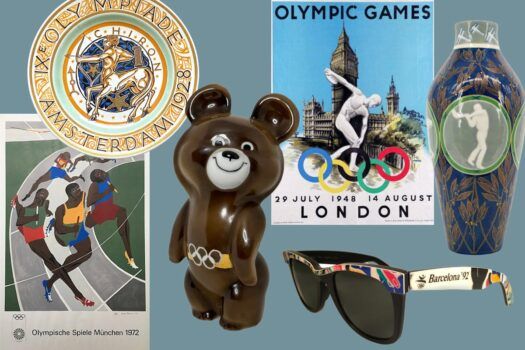
It’s ironic that holding a phallic object between your teeth has been seen as the height of manliness for generations of powerful, heterosexual men.
For nearly two centuries, cigar smoking has been associated with wealth, status, strength and, most of all, masculinity.
But in recent years, the pastime’s reputation has shifted toward the negative, as inhalable nicotine products have been deemed unhealthful for everyone within breathing distance of a plume, and a certain brand of masculinity itself has been reassessed as toxic.

Still, cigar culture writ large has left behind an array of splendid innovative smoking accessories that collectors covet, whether they continue to smoke in the 21st century or not.
Italian marble ashtrays have been repurposed as handsome catchalls for keys and coins; leather or silver cigar cases may hold stationery, pens, smartphones or cosmetics.
A new exhibition, “Smoke Signal: Cigar Cutters and Masculine Values,” on view at the Wolfsonian-FIU museum in Miami through September 29, looks at this phenomenon through the lens of 360 cigar cutters, donated by local collector Richard Kronenberg, who has been acquiring them since the 1960s.

“The mid-to-late 19th century through the First World War was the golden age of cigar smoking,” says Wolfsonian curator Lea Nickless, noting that in the United States in the early 1900s, “9 out of 10 men smoked a cigar at least once a week.”
The cutters, which are used to snip the cap off the end of a cigar to make it smokable, came in a huge variety of figurative shapes and styles, offering a surprisingly clear glimpse into the culture of their time.


There were sculptural desk-top cigar cutters for the study, discreet pocket versions and jewellike ones worn on pocket-watch fobs and attached to vests.
The devices featured images related to the gentlemanly sports of yachting, hunting, safariing and horse racing; exotic, erotic or bawdy portraits of women; and advertisements promoting such goods and services as champagne, shoes, welding and locksmithing.
A (Mainly) Manly History of Cigars
Cigar smoking hasn’t always been a male pursuit. For centuries, in indigenous cultures throughout the Americas, women and men lit uncured stogies for medicinal, spiritual and ritualistic reasons, as well as for pleasure, as evidenced by pre-Columbian artifacts. The word cigar derives from the Mayan verb sikar, which translates as “to smoke rolled tobacco leaves.”
After Christopher Columbus dropped anchor off Cuba on October 29, 1492, he sent two crewmen to investigate the island. The Spaniards witnessed men and women puffing on raw tobacco leaves wrapped in corn husks. Eight days later, they saw the same cigars on the island of San Salvador. When the explorers returned home to Spain, they brought tobacco with them.
Cigar smoking thrived among the elite in Spain and Portugal for the next 300 years, spreading to Holland and Russia by the 1750s. Russian empress Catherine II put silk coverlets around her cigars to protect her fingers from staining, thus inventing the cigar band.
By the 1800s, the British, French and Americans had acquired a taste for puffing on cigars. From that time on, they were considered a predominately male vice, particularly during the Victorian era.
Queen Victoria herself detested cigar and pipe smoke. And the city of Boston banned smoking on public streets in 1880. As a result, the smoking room was born.
Men would retreat to these fume-filled dens for cigars, libations and male bonding. “It was an opportunity for men to get together, network and talk business and tell tall tales,” Nickless says.
After the advent of photography, influential figures like Mark Twain, Ulysses S. Grant, Theodore Roosevelt and King Edward VII were pictured chomping on cigars, solidifying smoking’s status as a high-class habit.
In fact, right after his 1901 coronation, King Edward declared, “Gentlemen, you may smoke,” an allusion to the end of the tobacco prohibition imposed by his late mother, Queen Victoria.


By World War I, Nickless says, “cigarettes had become the latest tech for getting nicotine into the system. They were less expensive, seen as healthy and deemed acceptable to women.” But the image of the dominant male cigar smoker remained.
The mid-20th century saw such illustrious stogie devotees as Winston Churchill, Ernest Hemmingway, John F. Kennedy and Fidel Castro, and cigar sales hit a new high in 1964 after the U.S. Surgeon General deemed them healthier than cigarettes.

In the late 20th century, the “manliest man” of our time, Arnold Schwarzenegger, famously became a cigar aficionado, and Wall Streeters still smoked expensive Cuban imports (illegal in the U.S.) to show off their wealth and pluckiness.
With the women’s liberation movement, more females entered the workforce and earned a disposable income, which some of them spent on traditionally masculine luxuries like single-malt scotch and hand-rolled cigars.

In fact, the early 1990s birthed a stogie boomlet as women began taking up cigar smoking as an expression of their power, affluence and independence. Raquel Welch, Whoopi Goldberg and Demi Moore were all proud smokers, while supermodels like Linda Evangelista, Claudia Schiffer and Heidi Klum were photographed mouthing cigars.
From the 1990s on, the biggest female pop stars, from Madonna to Rihanna, have been lured by the aura of dominance and sophistication associated with cigar smoking. It’s hard to believe now, but seeing a woman, particularly a young one, with a cigar was viewed as a shocking flip of age and gender roles. Power was no longer an old man’s game.
Cigar Accessories Maintain Their Appeal

These days, hand-rolled cigars remain luxury items in themselves — selling for up to $1.3 million per stick — because of their rarity and the artisanal skill required to make them. “Beyond their rich aromas and intricate craftsmanship, cigars evoke a bygone era of elegance and fortitude,” says Alexander Pushkin, founder of Pushkin Antiques, in Royal Tunbridge Wells, England.
Accordingly, many of the tools involved in their storage and consumption — cigar humidors and cigar boxes, cigar cutters, cigar lighters and ashtrays — are collected as refined objets d’art.

“People purchase a diverse array of items, which have to be functional and stylish,” Pushkin explains. “Each piece must be beautiful to enhance the overall experience and, equally important, practical to honor the cigar and treat it with the utmost care it deserves.”
Another antiques specialist, Matthias Mattmer, of Van den Andern, in Nuremberg, Germany, breaks down the market for cigar-related objects this way:
- “Cigar humidors are essential for storing cigars at the proper humidity. Collectors often look for high-quality, aesthetically pleasing humidors made from fine woods or adorned with intricate designs.
- “Different types of cigar cutters — guillotine, V-cut, punch — are collected for their functionality and craftsmanship. High-end brands offer cutters with luxurious materials and precise engineering.
- “Cigar lighters, especially butane torch lighters, are collected for their reliability and design. Some collectors favor vintage or limited-edition lighters from prestigious brands.
- “Cigar-specific ashtrays are designed to accommodate the larger size of cigars. Collectors look for ashtrays made from fine materials like crystal, porcelain or metal, often with unique designs or branding.
- “Cigar cases are portable storage solutions that protect cigars when traveling. Collectors appreciate cases made from high-quality leather or other premium materials, sometimes branded by famous cigar makers.
- “Beautifully designed cigar boxes, especially those from well-known brands or with historical significance, are also popular collectibles.
- “Vintage advertisements, posters and promotional materials from cigar companies are collected for their historical and artistic value.”

Many of these collectibles are being rediscovered by fans of fine artisanship and vintage style.
Cigar ads get framed and hung on the wall as art. Gorgeous hardwood humidors might store barware, tea sets, snacks or even underwear. Cigar boxes have been recycled as planters, purses, jewelry boxes and holders of guest-room necessities.

Beyond serving as catchalls, crystal, porcelain and bronze ashtrays are now used to serve Kalamata olives, hard cheeses, hummus and devils on horseback. And with the widespread legalization of cannabis, a lot of these old items can be dusted off for something close to their original function.
Although we have good reasons for leaving behind the ideal of the swaggering, hard-drinking, cigar-chomping man of yesteryear, we can still remember him with a certain fondness. And we can salvage the relics of his good taste and refinement.









